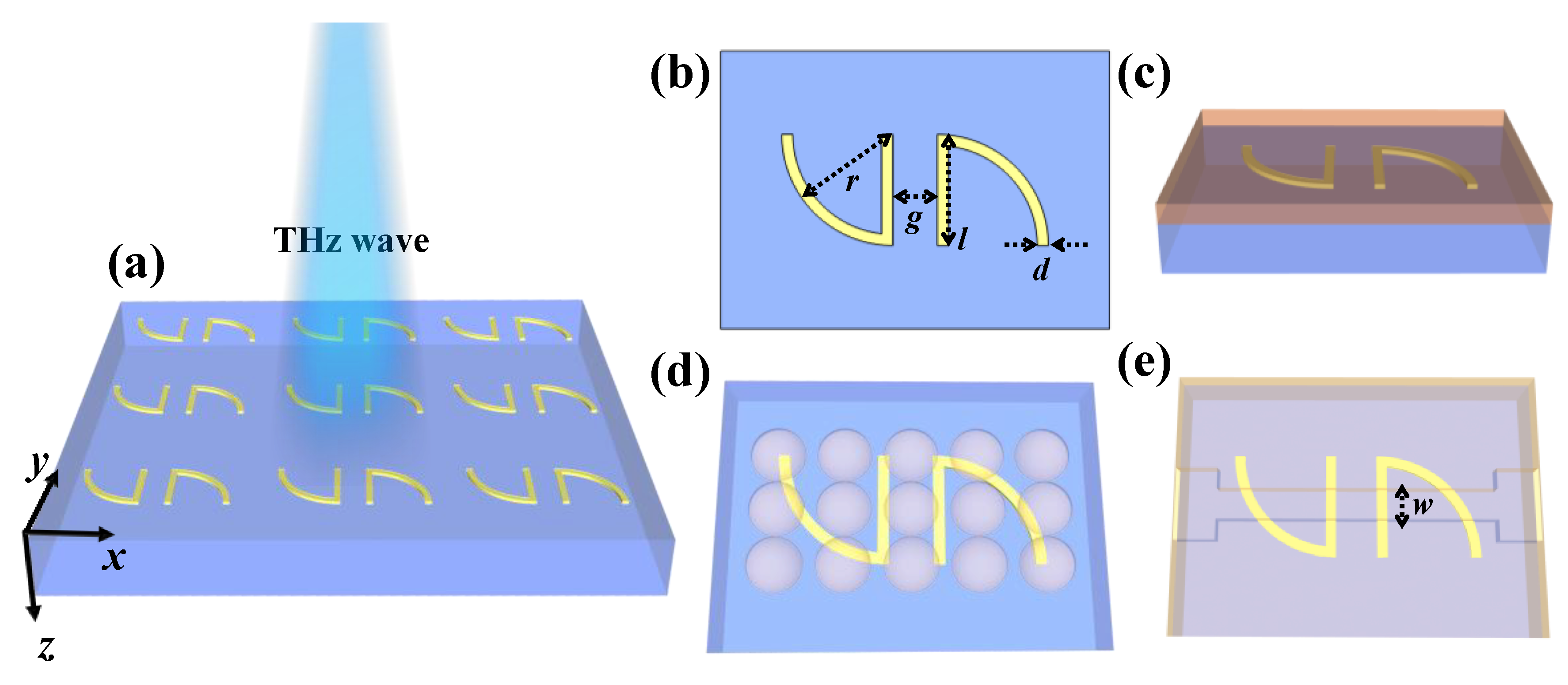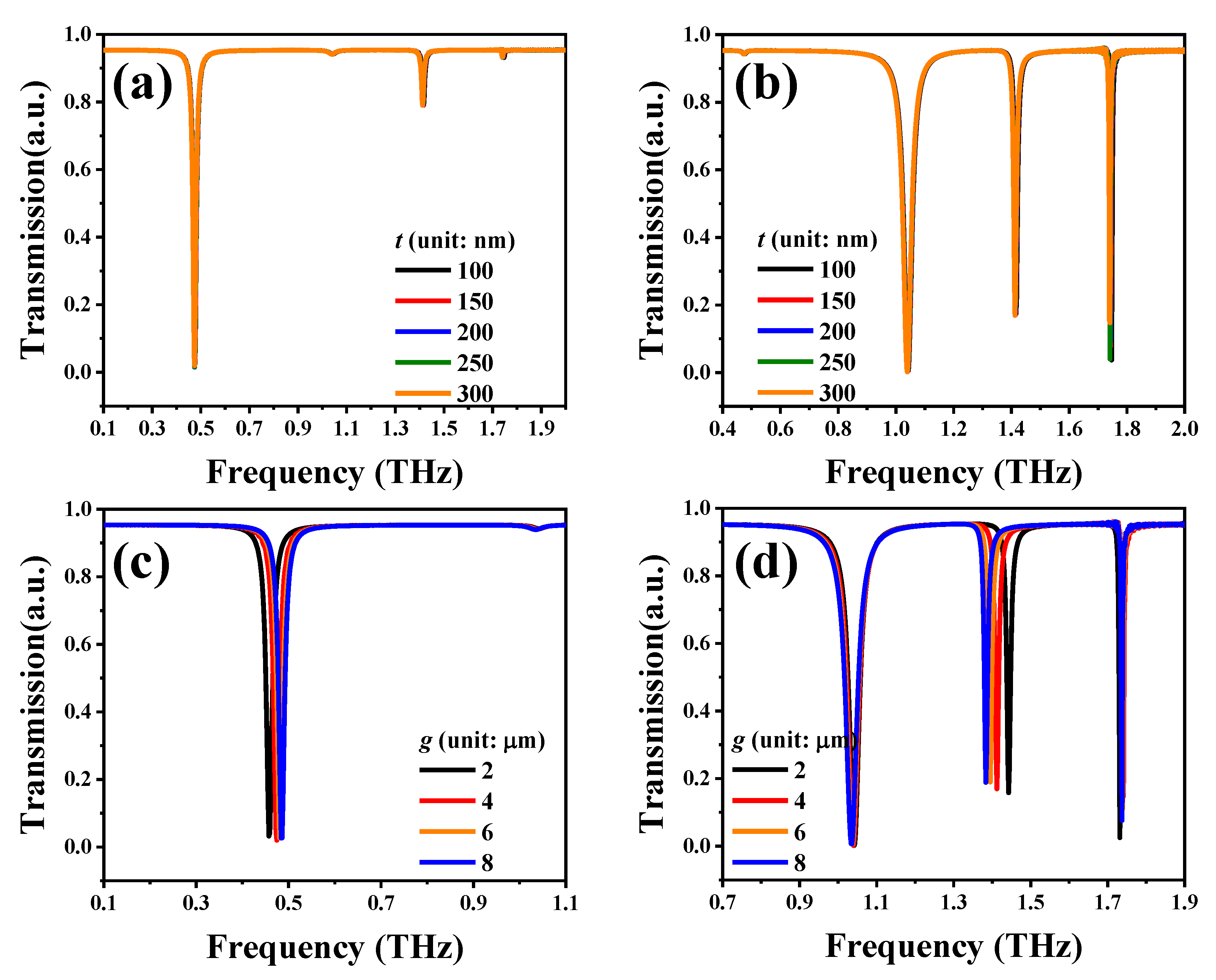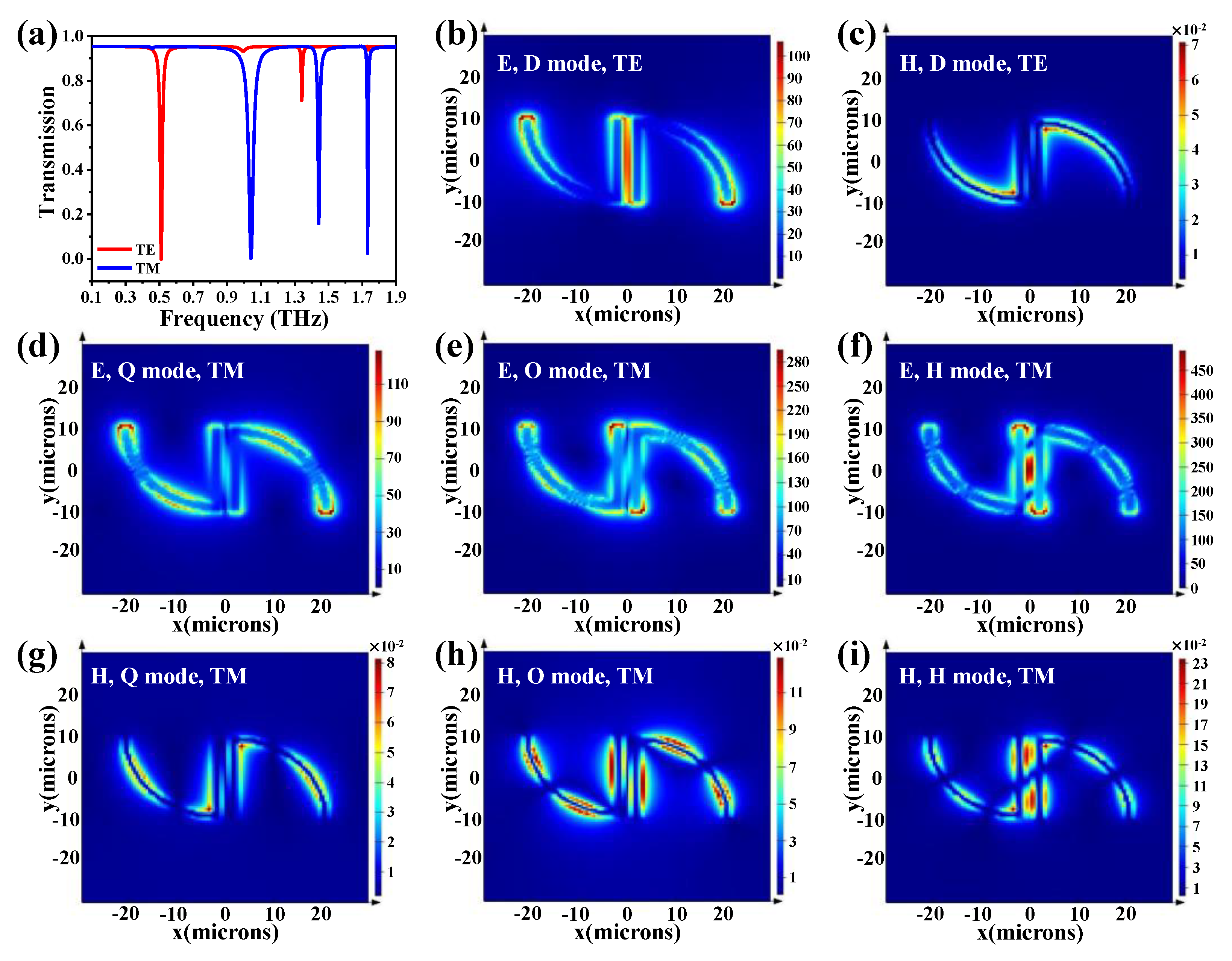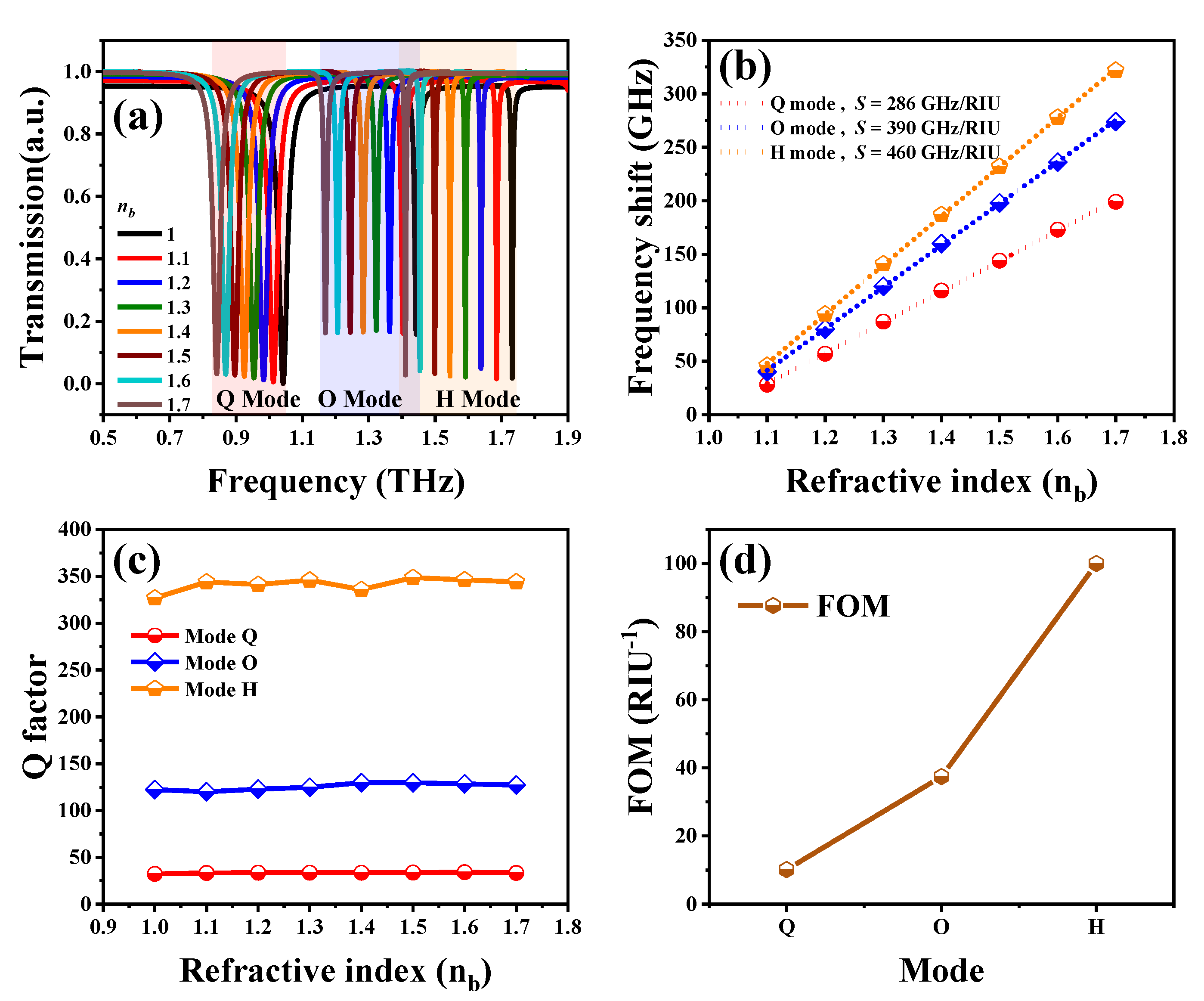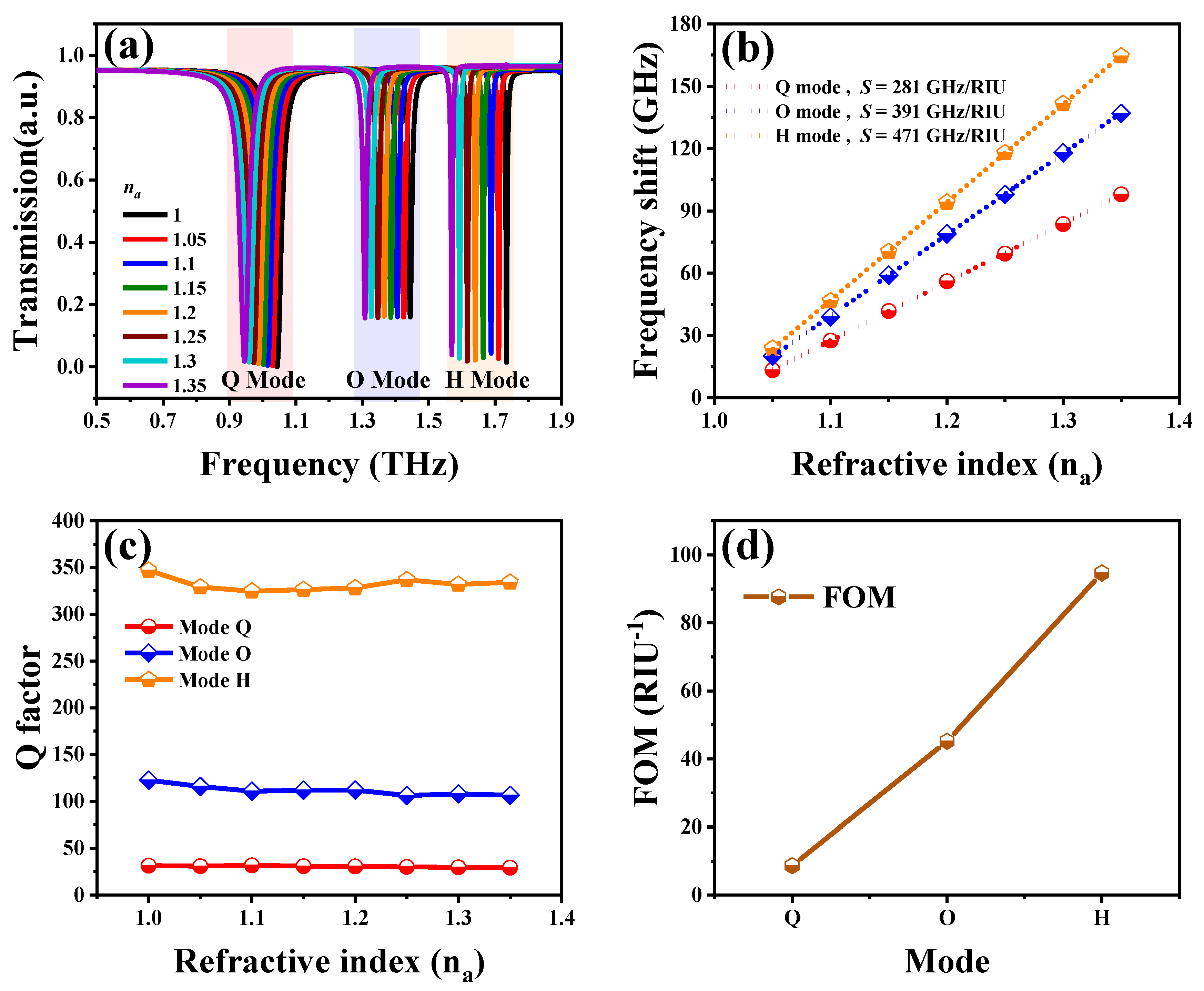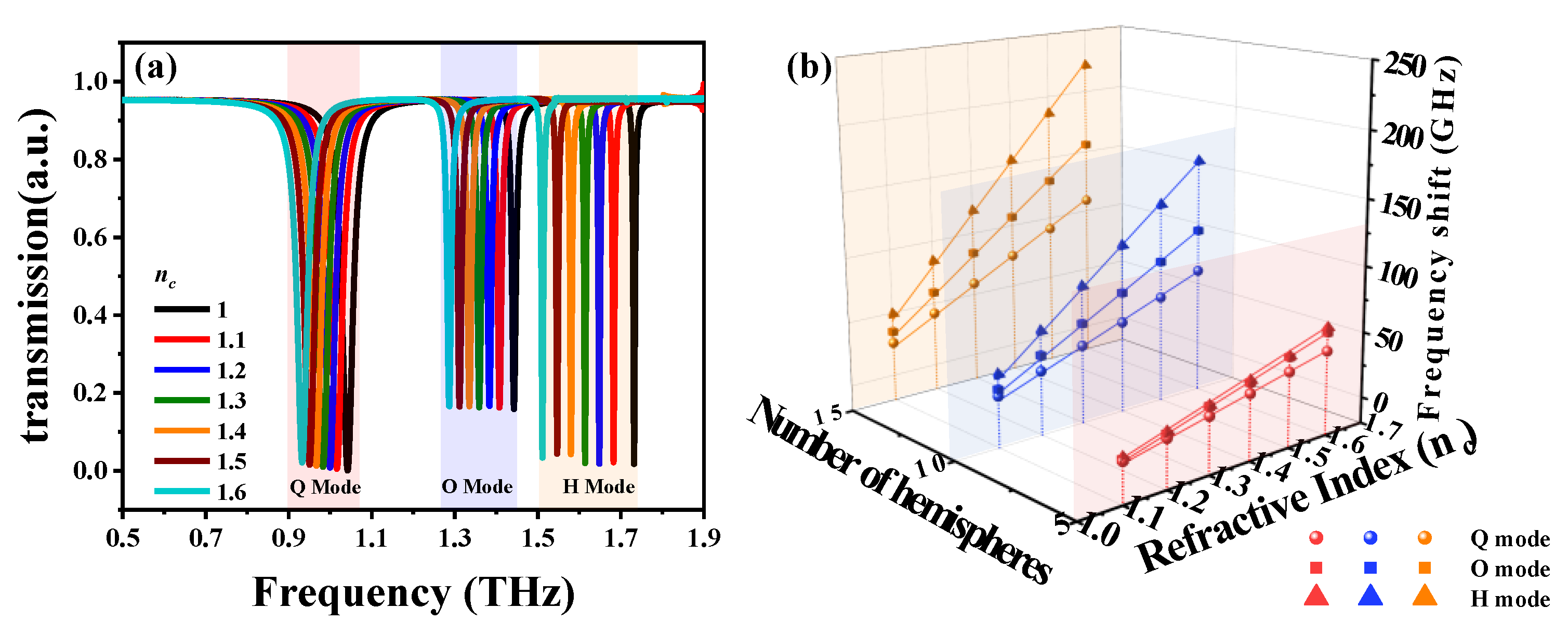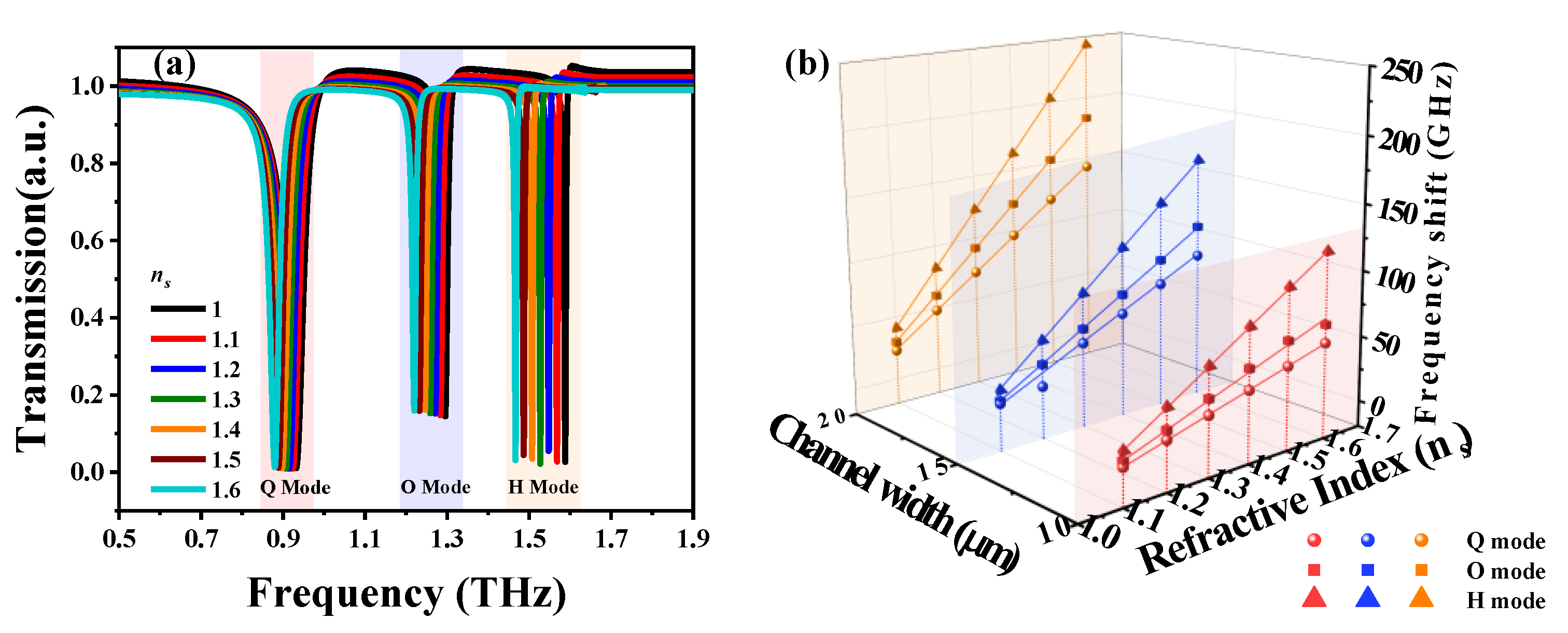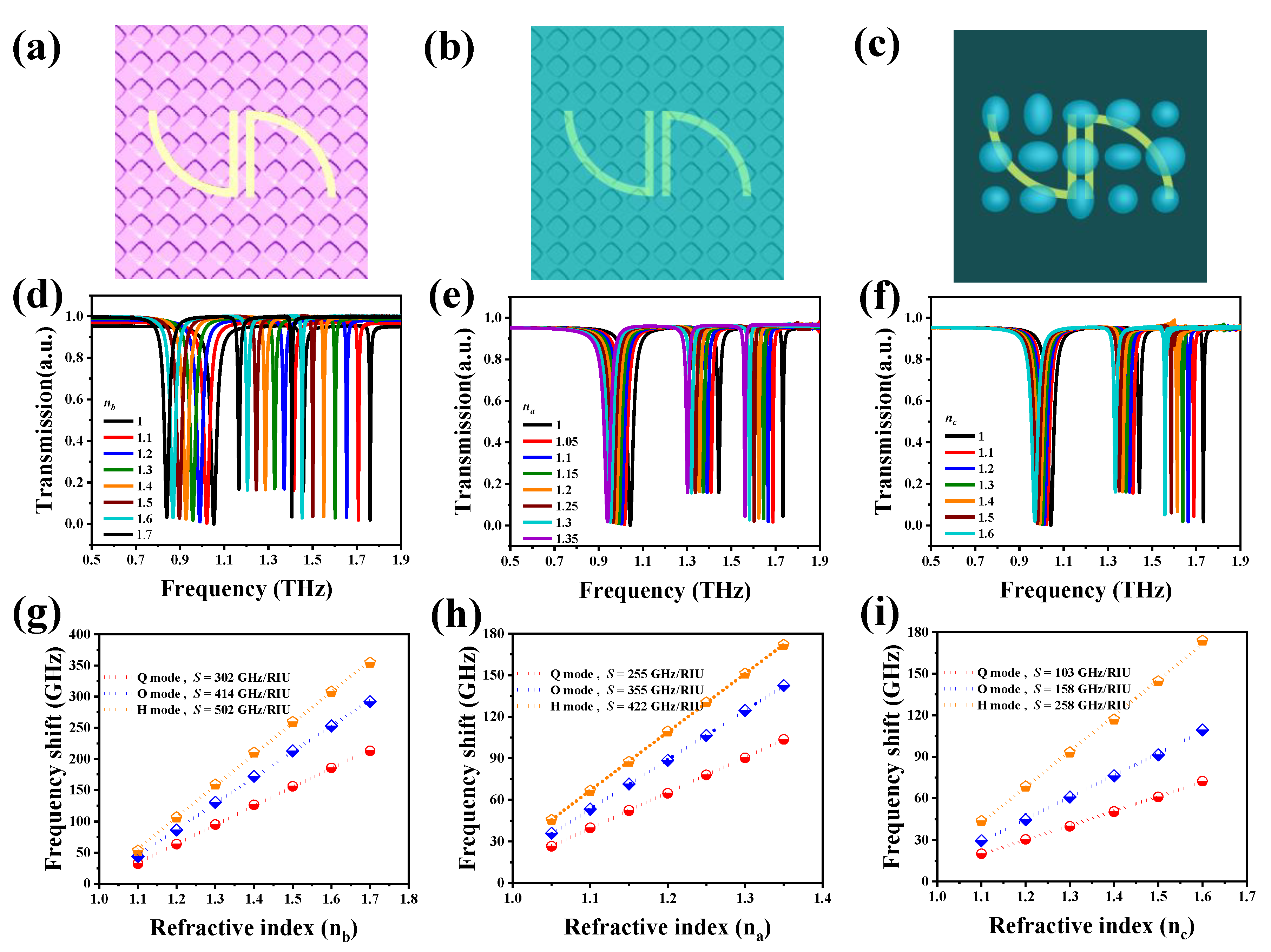1. Introduction
Recently, terahertz spectroscopy has attracted great interest due to its unique characteristics and availability in massively promising applications [
1,
2,
3]. It has many photoelectric characteristics, such as low photon energy but high penetration, as well as non-contact and label-free inspection, which enable terahertz spectroscopy technology to detect chemicals and biomolecules [
4,
5]. In addition, terahertz waves are consistent with the inherent frequency of some important biomarkers, such as nucleic acid and specific proteins, which make terahertz biochemical sensors possible [
6,
7,
8]. However, the optical properties of natural materials are inherent and cannot be changed. Moreover, terahertz waves’ transmission is high for common plastics and fibers, and their reflectivity is also high for most metal materials. These optical properties represent a bottleneck for the interaction between natural materials and terahertz waves [
9]. Metamaterial is a composite material that possesses unique electromagnetic properties realized by the configuration of specific structures. Near-field electromagnetic energy can interact and then be enhanced within the metamaterial. The combination of terahertz waves and metamaterial means that the incident electromagnetic wave can be controlled and manipulated.
The configuration of a metamaterial is a kind of synthetic subwavelength array structure which features negative permittivity, permeability, perfect absorption and superlens capability [
10,
11]. Metamaterial can be designed to possess single, dual, triple and multiple resonances by tailoring diversified metamaterial patterns and structures [
12,
13,
14]. Among these plasmonic resonances, the frequency shift of higher-order plasmonic resonances with high quality factors (Q-factor) is ultrasensitive to the geometrical shapes and the local dielectric environment [
15,
16]. Therefore, plasmonic metamaterial-based sensors are usually compact, portable and cost-effective, possessing great potential for detecting different kinds of chemicals as well as biomolecules in trace amounts [
17,
18,
19]. The utilization of plasmonic metamaterial-based sensors with high efficiency and high Q-factors is the essential reason for developing an ultrahigh-sensitivity biosensor.
In this study, a plasmonic metamaterial-based biochemical sensor with multiple resonances and high sensitivity is presented in the terahertz frequency range. The proposed plasmonic metamaterial is composed of an array of a pair of centrosymmetric sickle-shaped metamaterials (SSM). The ambient environments and analyte varieties were changed to investigate the sensitivity of SSM-based biochemical sensors. The higher-order plasmonic resonance was accompanied by a larger red-shifting of the resonance. The highest sensitivity was 471 GHz/RIU (refraction index unit) for the hexadecapolar plasmonic mode of SSM. The corresponding figure of merit (FOM) was 94 RIU−1. We further investigated the influences of dielectric hemispheres and microfluidic chips to imitate the dry and hydrous biological specimens. The results show that the red-shifting of the resonance could be increased by raising the number of hemispheres and the channel width of the microfluidic chip. The relationships between resonance shifting, hemisphere quantity and the channel width of the microfluidic chip are quite linear. The proposed SSM device provides an effective approach to detecting and analyzing the chemicals and biomolecules.
3. Results and Discussion
Figure 3a shows SSM transmission spectra in TE and TM modes under the condition of an environmental refraction index of 1.0. The geometrical parameters are kept constant at
r = 20 μm,
d = 2 μm,
l = 20 μm,
g = 4 μm and
t = 200 nm. Here, the environmental refraction index is denoted as
nb. A single resonance is at the lower frequency of 0.51 THz for the incident TE-polarized light, as the red curve shows in
Figure 3a, while there are three resonances at the higher frequencies of 1.04, 1.44 and 1.73 THz for the incident TM-polarized light, as the blue curve shows in
Figure 3a. The spectrum shape of the resonance is narrower at higher resonant frequencies than at lower resonant frequencies. This is one of the prominent characteristics of multipolar plasmon modes. In addition, the higher-order plasmon mode exhibits higher sensitivity in refraction-index sensing applications. The electromagnetic-field distributions of SSM at corresponding resonant frequencies are displayed to better understand the multipolar plasmon modes. The E- and H-fields of four resonances in the sorting orders are shown in
Figure 3b–i. In
Figure 3b, in terms of a single SRR, the E-field energy is mainly distributed on two sides, implying that this resonance is generated from the electric dipolar mode. Actually, the order of plasmon modes (o) satisfies the equation o =
n − 1, where
n is the number of notes in an open SRR [
12]. For instance, the
n and o values in
Figure 3b are 2 and 1, respectively, and so the resonance mode at 0.51 THz is the fundamental plasmon resonance mode, i.e., the dipolar plasmon mode (D mode). Analogously, the orders of plasmon modes in
Figure 3d,
Figure 3e and
Figure 3f are 2, 3 and 4, respectively. This indicates that the resonance modes at 1.04, 1.44 and 1.73 THz are quadrupolar (Q), octupolar (O) and hexadecapolar (H) plasmon-resonance modes, respectively. The phenomena of different plasmon modes excited by different polarized waves could be explained in terms of structural asymmetry and phases of internal fields. The gap in a split ring leads to polarization anisotropy and allows both odd and even plasmon modes to be excited. When the symmetrical structure is broken, that can be stimulated and then generate higher-order plasmon modes, such as Q and O modes [
12,
25,
26]. The incident TE-polarized wave results in internal fields with opposite phases on both sides of the SRR. Therefore, the E-field energy is coupled with the SRR, generating the fundamental plasmon resonance, which is the dipolar mode, as the red curve shows in
Figure 3a. When the incident polarized wave is perpendicular to the split gap, i.e., the TM mode, the confined electromagnetic fields are in same phases on both sides of the SRR. The even-order plasmon modes, such as Q and H modes, are thus generated, as the blue curve shows in
Figure 3a. The O mode is generated from the electromagnetic wave excited in TM mode due to the mirror symmetrical structure being broken.
The strong localized E- and H-fields emerged on the designed SSM surface, which indicated that a sharp resonance with a high Q-factor will be generated. In order to utilize the above-mentioned merits of multiple resonances in biosensing applications, we further compared and analyzed the changes of the surrounding environments and analyte varieties and then covered the SSM surface with different dielectric hemispheres and microfluidic chips to investigate its influence on sensing performance. The environmental refraction index (
nb) was changed from 1.0 to 1.7 to verify the sensing ability of SSM. The transmission spectra of SSM with different
nb values in TM mode are shown in
Figure 4a. There are three resonances at 1.04, 1.44 and 1.73 THz for the initial condition of
nb = 1.0. By increasing the
nb value, the resonances are apparently red-shifted and the resonant intensities kept stable.
Figure 4b plots the relationships between frequency shifts and
nb values. The resonant frequencies are red-shifted linearly by increasing
nb values. The shifting range of H mode is the largest compared to that of Q and O modes. The sensitivity (
S) of an SSM is defined as the derivative of the frequency shift with respect to the refraction index, i.e., the slopes of the dashed lines shown in
Figure 4b. The calculated
S values of Q, O and H modes were 286, 390 and 460 GHz/RIU, respectively. Furthermore, when the order of the plasmon mode increases, the resonance becomes sharper and the spectrum width is narrower. Q-factor is defined as the ratio of resonant frequency to the full width at half maximum (FWHM) transmission intensity, which is used to describe the quality of each resonant frequency. In
Figure 4c, Q-factors of Q, O and H modes are quite stable and insensitive to
nb values. The average Q-factors are 33, 124 and 342 for Q, O and H modes, respectively. For biosensing performance, FOM is an important factor that determines the sensing abilities in the biochemical and biomolecule applications. FOM is defined by
S/
FWMH. The average FOM values of Q, O and H modes are 10, 37 and 100 RIU
−1, respectively, as plotted in
Figure 4d. The sensing ability of SSM could be enhanced by increasing the order of plasmon modes.
We also investigated the effect of SSM covered with an analyte thin-film to compare the sensing ability of SSM. The refraction index of analyte thin-film is denoted as
na. The thickness of analyte thin-film is 10 μm, as shown in
Figure 1c. The transmission spectra of SSM with different
na values from 1.0 to 1.35 are shown in
Figure 5a. There are three resonances red-shifted by increasing
na values. To express the red-shifts of three plasmon modes explicitly, the relationships of frequency shifts and
na values are summarized in
Figure 5b. The relationships are quite linear. The frequency-shift tendency reveals that the sensitivity of H mode (471 GHz/RIU) is higher than that of O mode (391 GHz/RIU) and of Q mode (281 GHz/RIU). To further obtain the quantitative descriptions for the sensing performances, Q-factors and FOM values of plasmon modes were calculated, as shown in
Figure 5c,d, respectively. The average Q-factors of Q, O and H modes were 31, 112 and 328, respectively, while the average FOM values of Q, O and H modes were 9 RIU, 45 and 94 RIU
−1, respectively. The frequency-shift mechanism derived from the variation of
na values can be explained by the perturbation theory [
5,
9,
27,
28].
Here, perturbation means the variation of
nb values.
E0 and
H0 represent the unperturbed E-field and H-field, respectively.
(
) and
(
) are the changes to the dielectric constant and permeability after perturbation, respectively.
(
) is the change to the resonant angular frequency and
v0 is the effective integral volume. It should be noted that Equation (2) is based on shape perturbations in terms of SSM. The perturbation is
nb, with no
v0. In addition, the effect of permeability on frequency shifts is negligible since the proposed SSM is non-magnetic. Therefore, it can be expressed by:
It can be seen that the value decreases by increasing the nb value according to nb = . Consequently, the value decreases and the resonant frequency is then red-shifted.
Figure 6a shows the transmission spectra of SSM covered with different hemispheres under the condition of a hemisphere quantity of 15. The resonances are red-shifted by increasing
nc values from 1.0 to 1.6. This indicates that the proposed SSM device has the ability to sense biological cells with different refraction indices. The relationships of
nc values and frequency shifts are summarized in
Figure 6b. SSM exhibits an effective frequency shift by increasing the hemisphere number or plasmon mode. For example, when the hemisphere number is fixed at 10, as the blue plane shows in
Figure 6b, the resonances are red-shifted with a slope of 262 for H mode. This is larger than that of O mode (slope = 174) and of Q mode (slope = 119). Moreover, when the
nc value is kept constant, the frequency shifts become larger by increasing the hemisphere number. The proposed SSM is useful for the detection of cell proliferation or cell apoptosis. When the plasmon mode is determined, the resonances are red-shifted with a slope of 359 for a hemisphere number of 15 in H mode. This is larger than that for a hemisphere number of 10 (slope = 262) and a hemisphere number of 5 (slope = 97) in H mode. The above-mentioned results indicate that the biosensing performance of SSM could be enhanced by either utilizing higher plasmon-oscillation modes or increasing the concentration of biomolecules.
We further investigated the sensing performance of SSM integrated with a microfluidic chip. This has great potential for sensing biosamples, owing to the fact that most biological specimens are dissolved in aqueous environments. Furthermore, the requirement for an injected analyte sample is micro-/nanoliters. This minute amount of analyte sample can significantly prevent the terahertz absorption of the water and thus improve the sensing capacity of SSM. The thickness and width of the microfluidic channel are 20 μm and
w, as shown in
Figure 1e. The microfluidic channel is superimposed on the split gaps of SSM, i.e., the region with strongest E-field energy. Therefore, the resonances of SSM could be tuned by injecting different chemical solutions into the microfluidic channel. Here, the refraction index for injecting chemical solutions into the microfluidic channel is denoted as
ns.
Figure 7a shows the transmission spectra of SSM with different
ns values from 1.0 to 1.6, keeping
w constant at 10 μm. SSM exhibits three resonances with consistently resonant intensities under the variation of
ns values. These three resonances are red-shifted by increasing
ns values for Q, O and H modes. The relationships between frequency shifts,
ns values and
w values are summarized in
Figure 7b. The relationships are kept linear between frequency shifts and
ns values by keeping the channel width constant. The resonances are red-shifted by increasing the plasmon orders. When a resonant plasmon mode is determined, the frequency shifts can be enhanced by enlarging the microfluidic channel width. Therefore, the highest sensitivity of an SSM integrated with microfluidic chip emerged in H mode when the channel width was 20 μm; this was 405 GHz/RIU. These results imply that the SSM device is ultrasensitive to the variation of the surrounding environment and thus is a potential platform for biosensing biological specimens.
In consideration of the realistic materials, including rough PDMS, crude analyte thin-films and irregular biological cells, three more realistic models were simulated to imitate real situations. The schematics of the top views of SSM on a rough PDMS substrate, covered with crude analyte thin-film and covered with random ellipse particles are shown in
Figure 8a–c. The roughness of the PDMS surface and the analyte thin-film was introduced by texturing surfaces, with the maximum texturing depth determined to be 200 nm. The random ellipse particles were introduced by determining three ellipse radii haphazardly in the range of 3 to 5 μm.
Figure 8d shows the transmission spectra of SSM on rough PDMS substrates with increasing
nb values. The resonances are red-shifted significantly compared to those results in
Figure 4a. This implies that the sensing capacity of SSM can be enhanced by texturing the substrate surface. The relationships between frequency shifts and
nb values are summarized in
Figure 8g. The sensitivities are 302 GHz/RIU for Q mode, 414 GHz/RIU for O mode and 502 GHz/RIU for H mode, which are greater than those results in
Figure 4b (286, 390 and 460 GHz/RIU for Q, O H modes, respectively). These enhancements are due to the additional space below the metallic SRRs after texturing the PDMS surface.
Figure 8e shows the transmission spectra of SSM covered with crude analyte thin-films with different
nc values. The sensitivities of Q, O and H modes are 26, 36 and 49 GHz/RIU, respectively, which are lower than those in
Figure 5a.
Figure 8f shows the transmission spectra of SSM covered with random ellipse particles with different
nc values. The sensitivities are 103, 158 and 258 GHz/RIU for Q, O and H modes, respectively. These values are lower than those in
Figure 6b. As mentioned above, the sensitivity could be improved by increasing the hemisphere number and channel width of the microfluidic chip. This proves that the results of the lower sensitivities in
Figure 8h,i, caused by the rough analyte thin-film and the deformation of ellipse particles owing to the coupling effects, are minor for SSM covered with a crude analyte thin-film and random ellipse particles.
